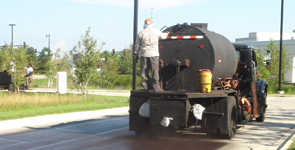Advantages to Squeegee Applied Sealer vs. Spray Applied Sealer
Using a squeegee machine to apply sealer puts pressure on the sealant giving it an opportunity to fill cracks and voids and create a better bond with the pavement surface.
PROPER SAND LOAD
The federal specification standard states that the proper sand load for a sealing project is four to five pounds of sand per gallon. Sand is the main bonding agent in sealer that acts as the grit of the product and contributes to the staying power of the sealer. The spray application method cannot guarantee these amounts. By using a squeegee machine to apply your sealer, you can ensure the proper sand load for every application.
EFFICIENCY & ACCURACY
 Squeegee machines apply sealcoat directly onto the asphalt surface. By forcing the materi- als deep into the pores of the hairline cracks of new or porous asphalt, we can ensure the most optimal protection. The squeegee machine also produces an evenly distributed textured surface that provides consistent wear and a slip resistant surface with every application.
Squeegee machines apply sealcoat directly onto the asphalt surface. By forcing the materi- als deep into the pores of the hairline cracks of new or porous asphalt, we can ensure the most optimal protection. The squeegee machine also produces an evenly distributed textured surface that provides consistent wear and a slip resistant surface with every application.
Key Point: By properly maintaining your existing asphalt, you can extend the life of your pavement and parking areas.
NO OVERSPRAY
Squeegee machines have no overspray. You don’t have to worry about product waste or getting sealer on curbs, landscaping or vehicles even on a windy day.
PERFORMANCE
RAPCO has four 1,500 Gallon Tanker trucks to transport material to your jobsite and four 300 gallon Squeegee Applicator machines to apply the sealer. Having a large inventory of equipment allows us to complete large-sized projects with aggressive schedules and offer cost-savings to our customers.
PRODUCT
RAPCO has all Pavement Sealer manufactured as a thermal ready-to-use product. This means that all sealer has been emulsified with a high shear mixing equipment with the precise amount of water added by the manufacturer—no water is added by RAPCO. The sealer comes from the manufacturer* directly onto your asphalt. This ensures the highest quality, longest lasting sealer that contains the most solids.






